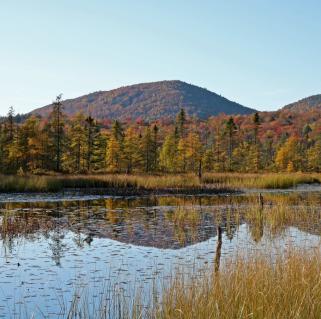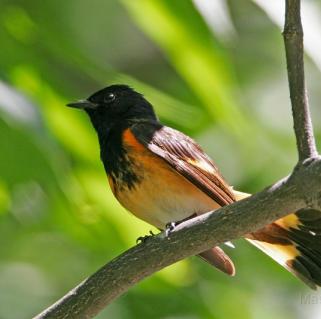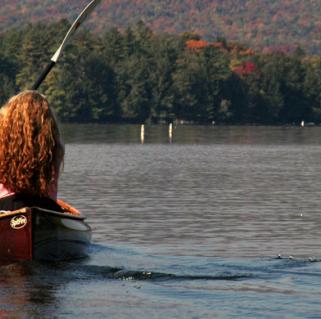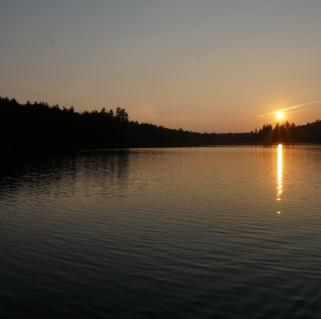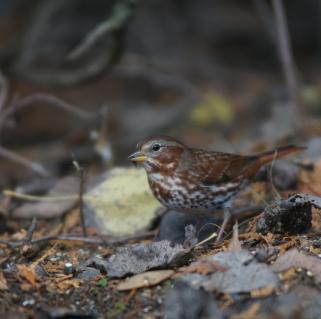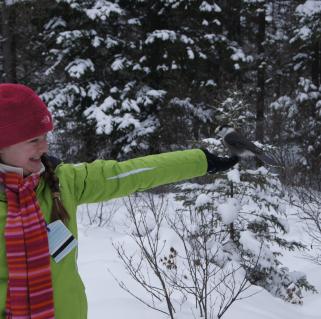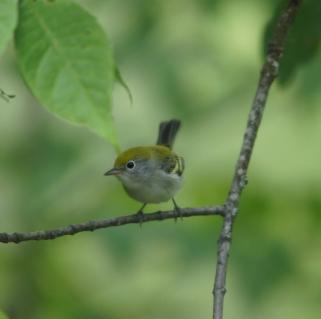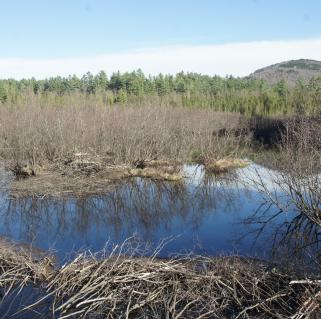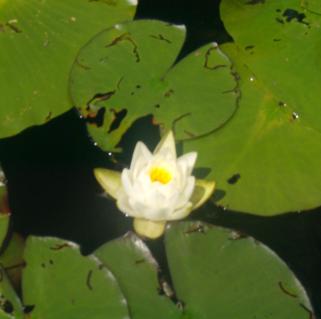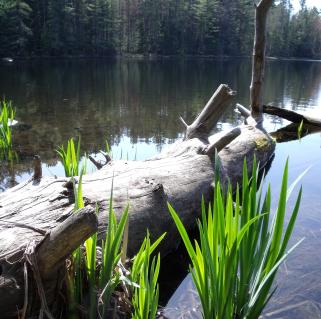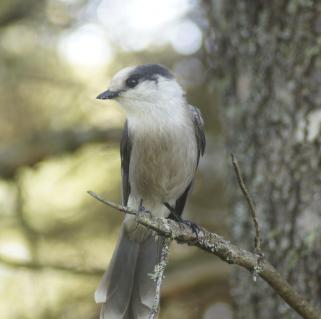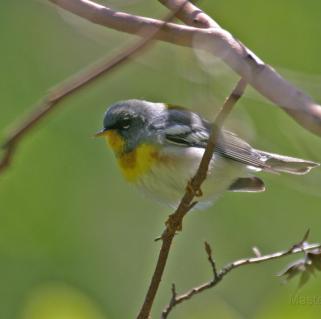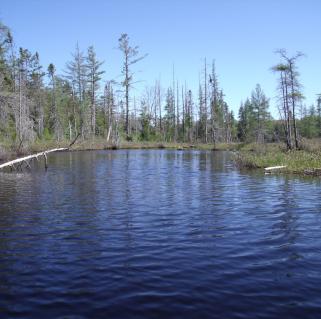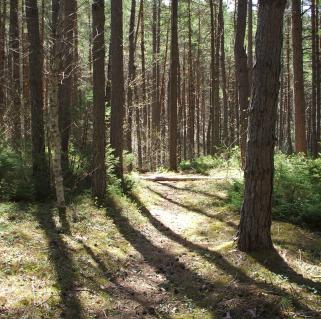Pamela Merritt
December 19, 2013
How I don’t get lost in the woods
I had a great day snowshoeing at the Paul Smiths Visitor Interpretive Center. It combines so many Adirondack passions into one place; wilderness, the arts, and learning. While it seems a world away, it’s so close to Saranac Lake.
I set out because it was a “bluebird day,” with blue sky above and white ground below. The VIC has wonderful hiking paths in summer, and mixed use paths in winter. I consulted with a helpful guide in the lobby. He pointed me towards two short loops designated for snowshoeing.
Then he added the fateful words, “It’s really easy, you can’t get lost.” This was the first time we had met, so he couldn’t possibly know how easily I can manage just that.
Fortunately, I also know how to get un-lost.
The map is not the terrain
Most of our trails are marked at intersections, and this is especially prominent at the lovingly cared-for trails at the VIC. And I have a map! For most folks, this is all that is needed. Even if they don't have a "compass in their heads," like many of my friends, they look at the map and they know where they are.
I do not have this talent. I can get turned around in a hotel hallway and not know which way back to my room. Being Spatially Challenged means I arrive at the intersection and take the wrong fork.
It doesn't really matter, because I soon encounter one of the color coded badges on the trees which remind me of which path I'm on. I'm supposed to be on the light blue Barnum Brook trail, but managed to get myself on the light gray Heron Marsh Trail (via Jenkins Mountain Trail, it turns out.) But if I hadn't taken a wrong turn, I would not have met this charming fellow.

I get entranced with my surroundings and pay attention to the wrong things. I was so swept up in the snowy landscape that I wasn't paying attention to the paths. But the chatter high up in the trees got my attention. This squirrel was so small I wasn't sure that's what he was, but I had never seen a chipmunk up that high. He apparently found me fascinating, too, because he came right down to the path and ran across it.
And my little friend made me notice the disk on the trees. Not the color I was expecting!
I must have made a wrong turn. So I did something that is key to Not Getting Lost: I turned around.
Don't stay lost: turn around
I mentioned that having a map is a great first step, but that is not something we can rely upon without thinking. What if we wind up with a map that is outdated or inaccurate? What if a bunch of trees have blown down and the path is obscured? What if, like me, we are daydreaming and miss something. something that the map assumes I have noticed?
We can always go back.
It turns out the number one mistake anyone lost can make... is also the most common reaction. As humans, we hate admitting we've made a mistake. This apparently continues right down to the cellular level, because whether we are in a deep woods forest or stuck on a city street, our first response is to try to Get There From Here.
While this has a good chance of working in downtown Manahattan, which has a number of ways to get "there," this is a poor response to getting lost in the woods.
If we go back, we know where we are, and we know where we are going.

So I retraced my steps, and didn't mind getting a second look at the lush scenery, such as this pond outlet. I found the intersection where I took the wrong fork, and this time, by holding the map upside down and spinning around to orient myself, I was able to choose the right one.
In summer, the boardwalks are obvious routes through bogs and marsh. In winter, it's especially important to "stay on the path" because that inviting meadow... isn't! It's always important to stay on any hiking path, since the vegetation can be fragile in any weather.
But staying on the path is also a great rule to follow when it comes to our own well-being. There's a limited amount of ways we can get lost if we simply stay on the hiking paths. They all wind up somewhere, after all. But stepping off of them puts us into a situation where everything can look like every other thing. Unless we are experienced nature noticers, we will find it difficult to get back to where we were, even if we only seem to take a few steps.

The Boreal Life Trail has both inviting vistas and close woods beauty to offer. The contrasts are thrilling. One of the challenges of hiking with children is keeping them interested when they do not perceive enough differences in the journey. This is especially true in winter, when much of the small differences are covered in snow.
We should encourage them to "see shapes" in the patches of vegetation that spring up from the white blanket, or compare the different kinds of trees, or be alert to differences in shrubs or terrain. Is this brook shallower or more turbulent than the last one we passed? Are we hearing more birds? Then we can wonder aloud why that might be so.
For us or for our children, being a "noticer" can be of tremendous help in choosing the correct paths, too. If we are doing looped trails, asking the children which one we have already been on is a great brain exercise, just as snowshoeing is a great body exercise.
Sit, and get lost in the beauty
But all good things need a break. If we are ready for one at the Paul Smiths VIC, we have some very historic seating at our disposal. The college students have made quite a few of these famous benches for us to rest upon.

These Leopold benches are named after their inventor, Aldo Leopod. He was a famous environmentalist and a founder of wildlife science, who designed this most simple of benches so people could more easily enjoy nature. From the looks of these paths, and the well-known outdoors gusto of Paul Smiths students, I might be wandering among the world's largest collection of Leopold benches!
Invite the children to keep a count.
As I near the end of my journey, the quality of the silence changes. I emerge from the deepest of woods to the more open grounds of the Visitor Center. Now I see roads and a gazebo and birdfeeders. I am feeling the walk through my whole body. We expend a lot of energy in winter snow and cooler temperatures. It's always best to underestimate our stamina.
These same paths will be different another day. And I might just get lost and explore a new one!

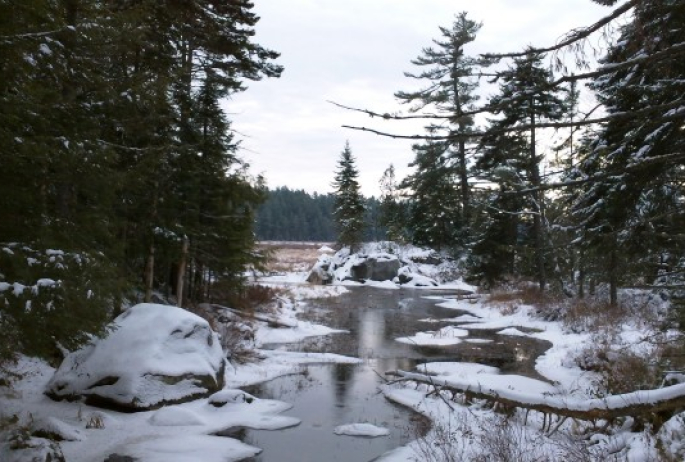


Packages and Promotions
Valid Dec. 1
- Dec. 1
Valid Dec. 1
- Dec. 1
Linger Longer in Saranac Lake
Best Western Saranac Lake
Linger Longer in Saranac Lake at our supremely located property, Best Western Saranac Lake. Stay 2 nights or more and get 15% off!
Valid May. 1
- Nov. 2
Valid Apr. 1
- May. 1
Forest Bathing Guided Experience - 10% off for pre-season registration
Adirondack Riverwalking & Forest Bathing
Guided forest sensory immersion walk for all. Sign up early for 10% off!
Valid May. 1
- Oct. 31
Valid Dec. 6
- Nov. 1
Zip and Whip Expedition
Farmhouse UTVs
Experience Outdoors and Farmhouse UTVs have teamed up to bring your family and friends the Adirondack adventure you've been waiting for....
Valid Jan. 21
- Jan. 21
Valid Jan. 21
- Jan. 21
Pet Getaway
Voco Saranac Lake
Your dog deserves an Adirondack getaway too. Book our pet friendly hotel near Lake Placid welcomes every member of your crew. Book our Pet Package...
Valid Jun. 20
- Sep. 7
Valid Mar. 12
- Jun. 30
Guided Nature Immersions - 10% off for Pre-Season Registration
Adirondack Riverwalking & Forest Bathing
Picture it now...you are wading the Ausable River on a warm summer day, feel the cool water against you, hear the sounds of the birds and the...
Valid Jan. 21
- Jan. 21
Valid Jan. 21
- Jan. 21
Stay and Dine
Voco Saranac Lake
Receive a 50 dollar credit per stay to use in our Boathouse Saranac Lake Pub. Enjoy an exceptional dining experience with unparalleled views great...






















